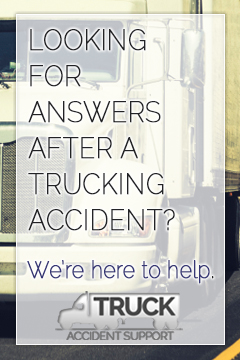Highway Safety
As AAA points out in 2010, there were over 5 million reported vehicle crashes. Within the 5 million vehicle crashes, there are 33,000 deaths, which average out to 90 deaths every day. To prevent the loss of lives and a truck and car accident, basic highway safety measures that include driving cautiously, properly using the safety equipment in the vehicle, and adhering to regulations relating to road conditions are crucial.
Highway Safety Tips
Driving cautiously and properly using the safety equipment in the truck or car prevents crashes. For example, leaving a car length for every increment of 10 mph while on the highway allows for ample reaction time. Be a defensive driver; keep an eye on the other cars and tractor trailers. Be aware of where tractor trailers’ “blind spots” are and avoid staying in the truck’s “blind spot.” Also, tractor trailers and cars should not be driven when fatigued.
Using Safety Equipment
Properly using safety equipment in the truck or car, such as the safety belt is important. AAA estimated that in 2010, seat belts saved over 12 thousand lives. Additionally, electronic stability control is a significant safety feature to have to keep cars and trucks from rolling over; the electronic stability control works to maintain cars and tractor trailers right side up. Also, side airbags will assist in saving lives when a truck or car does rolls over since the side airbags will protect the truck and car drivers.
Regulations of the Road
Adhering correctly to road conditions will help prevent a truck and car crash while on a highway. Highway safety includes adhering to the speed limit. Speeding does not significantly assist in drive time and puts many lives in danger. To further explain, AAA points out that if a car or truck is going 75 mph in a 55 mph zone on a 30 mile trip, the car or truck is only saving about 9 minutes of time.
Additionally, when the road is wet, cars and tractor trailers should slow down, avoid cruise control, leave more room between vehicles, and know what to do in the case of a skid. During a skid or hydroplaning, never hit the breaks and continue to steer and look in the original direction. If a tractor trailer or car hits the breaks during a skid it will offset the balance of the truck or car and increase the likelihood of a crash.
You Can Find Robert Dellecker on Google+
Sources:
Karush, Sarah, ed. N.p.. Web. 16 Oct 2013. <http://www.iihs.org/externaldata/srdata/docs/sr4807.pdf>.
NHTSA, . N.p.. Web. 16 Oct 2013. <http://www.nhtsa.gov/>.
“Road Safety Tips.” exchange.aaa.com. AAA. Web. 16 Oct 2013. <http://exchange.aaa.com/safety/roadway-safety/road-safety-tips/>.














